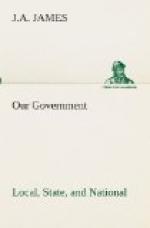The period included between September 28, 1787, when Congress transmitted the Constitution to the State legislatures, and June 21, 1788, when New Hampshire, the last of the necessary nine States, ratified, was one of the most critical in our history. Political parties, in a truly National sense, were formed for the first time. Among the leaders who defended ably the views of those who opposed the ratification of the Constitution were Patrick Henry, Richard Henry Lee, Elbridge Gerry, and George Clinton. It was urged that there was no bill of rights,[9] that the President would become a despot, and that equality of representation in the Senate was an injustice to the larger States. “Letters from the Federal Farmer,” prepared for the press of the country by Richard Henry Lee, set forth clearly the views of the Anti-Constitutional party.
[Footnote 9: A bill of rights, in which the idea of the rights of man were set forth, was a significant part of nearly all the State constitutions. Englishmen, generally, had been familiar with the formal statement of these principles since 1689, when William and Mary accepted the Declaration of Rights as a condition of their receiving the crown of England. During the same year Parliament gave the Declaration of Rights the form of a statute, under the name of the Bill of Rights. Among other rights it demanded that the king, without the sanction of Parliament, should not raise an army, secure money, or suspend the laws; also, that the right of petition, freedom in the exercise of religion, and equality under the laws were to be granted all subjects.]
“The Federalist.”—No influence was more noteworthy in bringing about ratification than a series of political essays afterward collected under the name of “The Federalist.” It is considered to-day the best commentary on the Constitution ever written. Alexander Hamilton originated the plan, and wrote 51 of the 85 numbers. James Madison wrote 29, and John Jay 5.
The Influence of Washington.—Washington was again a giant in his support of the Constitution. In a letter to Patrick Henry he early sounded an effective note of warning against anarchy, expressing the very fear that finally led many in the conventions to vote for the Constitution. He wrote: “I wish the Constitution which is offered had been more perfect; but it is the best that could be obtained at this time, and a door is open for amendments hereafter. The political concerns of this country are suspended by a thread. The convention has been looked up to by the reflecting part of the community with a solicitude which is hardly to be conceived, and if nothing had been agreed upon by that body, anarchy would soon have ensued, the seeds being deeply sown in every soil.”
Ratification Secured.—Delaware, the first State, ratified December 6, 1787, without a dissenting vote. Pennsylvania, New Jersey, Georgia, and Connecticut followed quickly. Much depended on




